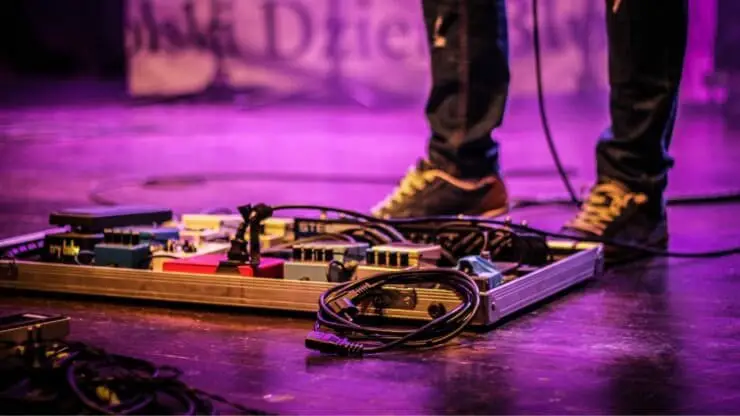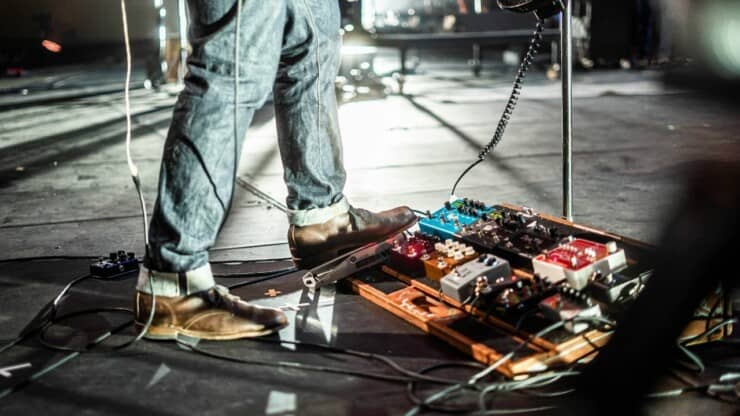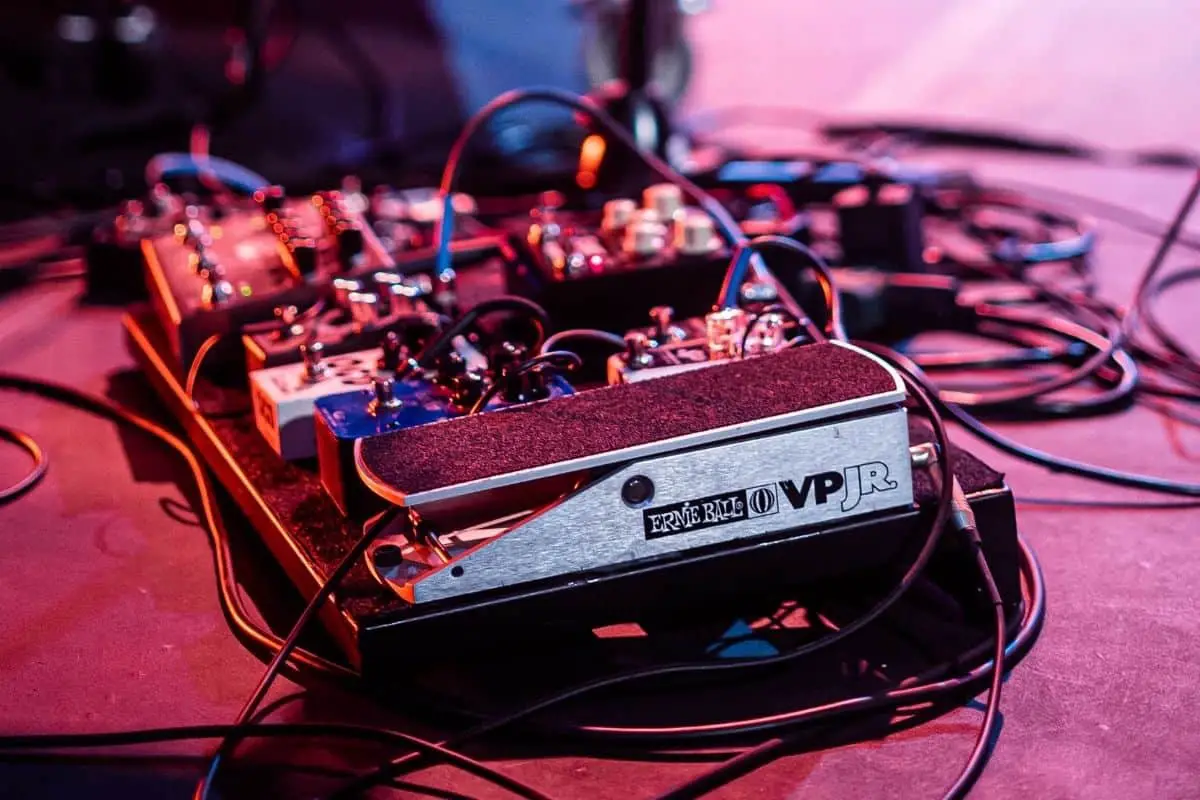Have you been learning to play the guitar and performing with a band and observed words like pedalboard thrown around? Don’t worry, even if you don’t know what is a pedalboard, you’ll get to know all about it here.
A pedalboard is a neat board that holds the effect pedals in your setup. Effect pedals are devices that offer specific enhancements to the sound of the guitar. Some common effects on the pedalboard are chorus, reverb, delay, and more.
In this article, you’ll get to know all about what is a pedalboard, how to organize the pedals in a pedalboard, what size pedalboard do I need, what is the best pedalboard for guitar, and more. Continue reading to know all the answers you’re looking for.
What is a pedalboard?
One of the first things that guitarists need to know when setting up the rig is what is a pedalboard. A pedalboard is just what the name suggests. It is a board capable of holding the effect pedals. Effect pedals are electronic devices that’ll make specific enhancements to the sound of the guitar.
The most common effects on the pedalboard are delay, chorus, reverb, wah, distortion/overdrive, and more. The pedals are normally housed in external switch boxes sitting on the floor and are switched on/off by stepping on small buttons on the box. These are often known as stompboxes.
The biggest advantage of using a pedalboard is that it’ll give a nice and tidy arrangement for the effect pedals. They can then be transported to jams, gigs, or to your training room or basement.
What size pedalboard do I need?
Another important consideration that you must think of before creating your first pedalboard is – what size pedalboard do I need?
When choosing the right size pedalboard, you’ll have to factor in the dimensions of the pedals, the space between the pedals, and the room for the power supply. You should also leave some room for extra pedals or consider if you’re looking for a smaller board for portability. Different pedals come with different dimensions, which is what makes it so complicated to decide the size.
If you’re using wide individual pedals, wah or volume pedals, or multi-effects pedals, you’ll require more space. Wah and volume pedals, in particular, are almost double the size of the standard-sized pedals. In such cases, you’ll require two rows and the pedals will take up both of them. Meanwhile, if you’re using mini pedals, then you are unlikely to need as much room.
If you’re new to pedalboard designing, you’ll need to quickly figure out how many pedals you’ll need on the pedalboard. This will allow you to understand how much space will be consumed and how much free space you can afford.
Having ample room for an extra 2-3 pedals would be okay. However, you shouldn’t get carried away. Moreover, you must remember that you can always swap out the pedals that you don’t need. Pedals don’t need to be included in the pedalboard all the time. This way, you can experiment and use the trial and error way until you get the perfect setup.
Decide how much room you’ll be needing
When you’re figuring out what size pedalboard do I need, there are essentially three things that you must consider. These three things will eat up all the room –
- The pedals
- The space between individual pedals
- The power supply
It’s important to have a look at each of them and determine the size you’ll want your pedalboard to be.
Effect pedals
It’ll be quite hard to forget about this aspect when you’re deciding on the pedalboard’s size but it’s important. You must be clear about it from the start. You must know how many pedals you’re going to use on your pedalboard. Moreover, you should also know the model of each pedal if you want everything to perfectly fit on the pedalboard. If you’re unsure about anything, you can always go for a slightly larger pedalboard. There are many types of effect pedals that can occupy different amounts of space.
Most pedals belong in the standard category and they’re around 5 x 3”. However, if you’re going to use wah or volume pedals or multi-effects, then you must know they’re significantly bigger. You’ll have to factor in these pedals as they’ll consume a lot more space.
The space between the pedals
In general, you’ll require around 2” space between each pedal on the pedalboard for the cables. Most pedals come with the input and output jacks at the opposite sides of the pedal. This is why having 2” will allow for the patch cable connection once the pedals have been organized in a row. Ultimately, the amount of space you’ll require will depend on factors like –
- The cables that you’re using
- The location of the input and output jacks
- Whether the pedals have been organized in a single row or multiple rows
The power supply
The final factor to consider when deciding upon the size of your pedalboard would be the power supply. This will only apply if you are using a power black instead of the AC adapter and daisy chain splitter. Many musicians feel that power brick is the superior option as it gives better sound quality. However, it takes up space on the board unlike, the daisy chain and adaptor.
How to organize a pedalboard?
Once you’ve amassed a cool collection of effect pedals, you’ll probably be wondering how to organize them onto a pedalboard. Understanding the fundamentals of arranging the signal chain will be a key part of getting the best of your pedalboard. This will, in turn, affect how well it’s working with the amp and how the overall tone comes out.
While some people say that there are no rules for organizing a pedalboard, and it’s true to a certain extent. Experimenting and coming up with out-of-the-box ideas can have you stumble upon unique combinations. However, there are actually some rules. Following these guidelines will ensure you get the best possible results. Similar to music theory, it’ll be useful to know the basic rules and once you’ve mastered them, you can learn how to experiment.
The five families of effect pedals will define how you’re organizing your first pedalboard. The effect pedals can be separated into five groups based on their functions and how they affect the tone.
- The pedals that affect dynamics and pitch
- The pedals that produce the tone
- The pedals that modify the tone
- The pedals that repeat or replicate the sound
- The pedals that create an ambiance
Pedals that affect dynamics and pitch
Pitch shifters and octave pedals take the guitar signal before transposing them up or down. This allows you to boldly go where standard-tuned instruments cannot go. The cleaner the signal is that’s fed to them, the better the tracking will be. This is why these effect pedals should be put in the first block, right after the tuner. If you put them after-effects like distortion or delay, they’ll end up sounding glitchy while also tracking notes poorly.
Additionally, feeding the pedals a more even-volume signal will help with note tracking and consistency. This is why you can position compressors in front of them to smoothen things.
Pedals that produce the tone
Pedals that tend to produce tones go before pedals that modify the tone. This is logical as you’ll want to create the basic sound first. Then, you’ll want to tweak it with some sort of modifying effects, such as overdrive or distortion. These pedals will take your clean guitar sound and give a gain tone. This ranges from light, edge of breakup tones down to the crunchy classic rock up to molten high-gain madness.
In case you’ve used distortion or overdrive before, you’d know that turning up the gain will turn up the noise floor of the signal significantly. This is why guitarists normally position the drive pedals early in the chain. If they’re added any later in the signal path, these can amplify the noise of everything before them. If you are using more than one dirt pedal for creating the sound, it’s known as stacking. As a general rule, you must stack them in order – from the lightest drive to the heaviest distortion.
Pedals that modify the tone
Once you’ve managed to settle on the core tone, it’ll be time to twist this into interesting new sounds. This can be done using modulation pedals. A chorus pedal can easily turn the guitar sound into a shimmery ensemble of voices, while simulating the sound of multiple instruments that are playing the same part.

Phasers and flangers will give the psychedelic swirl and jetplane swoosh that hits from the 80s are known for. Placing them after your drive pedals will give a more pronounced effect. However, many talented guitar players also prefer using modulation pedals before the drives. You can experiment and see which way works out best for your sound. If you want to do both, you can add modern multi-modulation units, as they have an insert loop function. This means that once you’ve placed the drive pedals in the effects loop of the pedal, you can easily switch between running modulation effects before or after the drives.
Pedals that repeat or replicate sounds
First off, you’ll get to know about the pedals that repeat the sound. These include effects like delay pedals that take the sound and bounce back at you. When you’re using this delay effect, you’ll want the chunky and swirly tones. You’ll want the tones you’ve crafted through the family of pedals that have been used until now. This is why this effect is being put near the end of the chain.
Putting delay pedals after distortion will also mean that the delay repeats fade out cleanly and evenly. If you’re putting the delay before distortion, the compression effect of the distortion pedal causes the delay repeats to smear together.
Meanwhile, the repeats would be a lot louder before they die out abruptly. But again, this might be the effect that you’re looking for. Many legendary guitarists like The Edge and Eddie Van Halen use delay pedals right into the front of overdriven amps. If you’re going to try that, you should keep the feedback and effect level lower than what you’d normally. If you are putting a delay in front of the amp, it’ll be best to use an analog delay. This way, the darker sounding repeats blend in better with the distorted sound.
As for the pedals that replicate the sound, this category includes loopers. Loopers aren’t actually effects. They are essentially recorders that guitarists use for building up a multi-layered sound. Normally, you’ll want the looper to be capable of recording and playing back the sound that you’ve created. Similar to the delay pedal, you’ll want to put the looper near the end of the chain. Where exactly you’ll be placing it will need some trial and error and a thorough understanding of how looping works.
You’ll also want to have some overdubs in the loop that make use of short delays. In such cases, the looper must come after the delay. On the other hand, it’ll almost certainly be placed before long delays and reverbs as they’re difficult to loop properly. In many cases, the professionals who use loopers on their guitars don’t use delay and looper at the same time. It’ll be easier to build loops without worrying about the added dimensions of delay repeats.
Similarly, are you looking for the reverb to be a part of the effect that you can record on the looper? If so, then you should order the looper after the reverb. What if you simply want to reverb to impart general ambiance and room feel to the overall playing? Then, you should put the looper before the reverb.
Pedals that create the ambiance
Reverb is what you’ll hear in the enclosed physical once the sound bounces off walls and ceiling to your ears. The amount of reverb that you’ll hear will relay to your brain the physical size of the space in which this sound is occurring. For better understanding – think of the difference between clapping in a small room compared to clapping in a cathedral.
This will be the final component of sounds in the real world. If you’re applying this philosophy to your signal chain, the reverb should come right at the end. A reverb pedal could take your dry guitar sound and add a 3-D space and ethereal ambiance impression. You’ll have the option to choose from a straightforward reverb or an ambient soundscape.
What is the best pedalboard for guitar?
Everyone’s budget and needs are different, which means there’s no particular answer for what is the best pedalboard for guitar. If you’re going with a few pedals, you could start with a mid-sized pedalboard. This will definitely give you the bang for the buck.

If you’re in the market for a high-quality board, you can consider a Pedaltrain board or a Voodoo Lab PP2 as it is used by several pro players. If you loved doing this your way, you can build your own pedalboard. It’ll be a great experience and give you enough room for customization. If you’re wealthy enough, you can pay for a high-quality pedalboard. There is absolutely nothing worse than a pedalboard breaking down during gigs or jamming sessions.
You should take time to research your pedalboard options, check out the online stores, read the reviews, and more. You can also research your favorite guitarist’s pedal setup.
Conclusion
Thank you for reading. Hopefully, now you know a lot more about pedalboards, what is a pedalboard, how to organize the pedals in a pedalboard, what size pedalboard do I need, what is the best pedalboard for guitar, and more. A pedalboard is essentially a neat board that can hold the effect pedals of your guitar setup. Some of the most common effects present on pedalboards are chorus, delay, reverb, and more. The biggest positive of using a neat pedalboard is that it’ll give you a tidy arrangement of the pedals. Moreover, you can transport the pedals to gigs, jams, or your training room.



